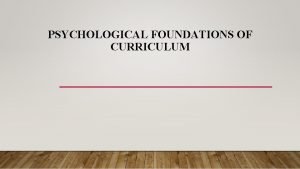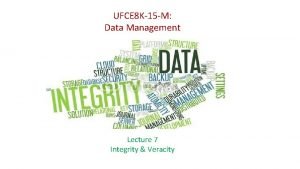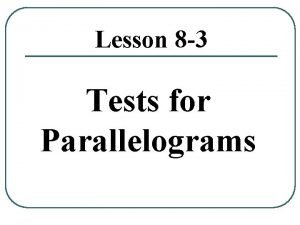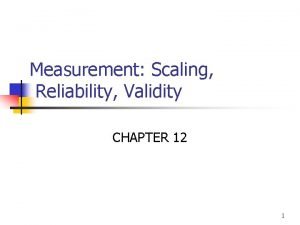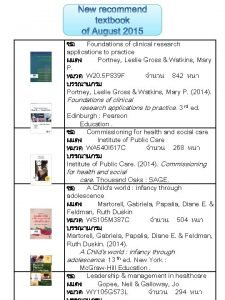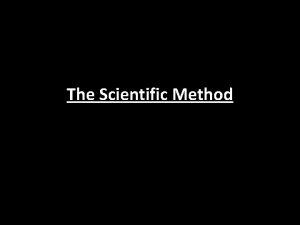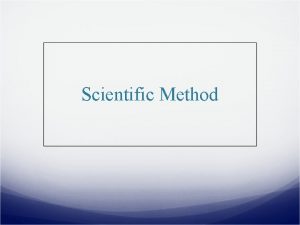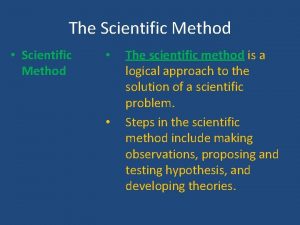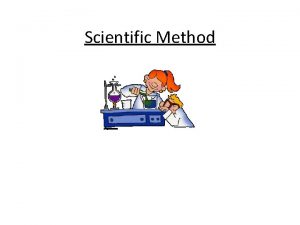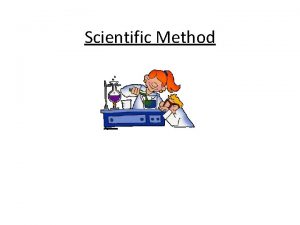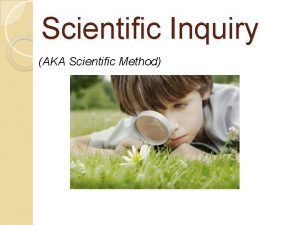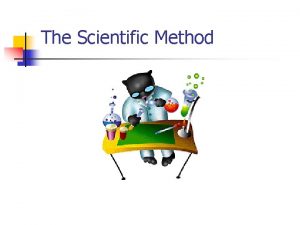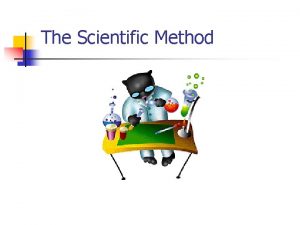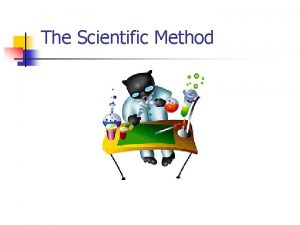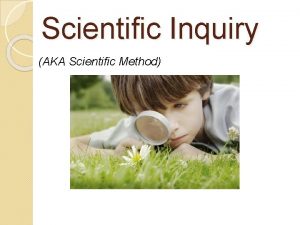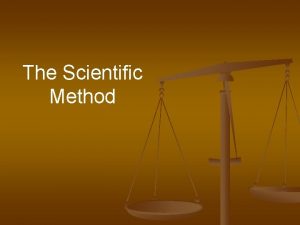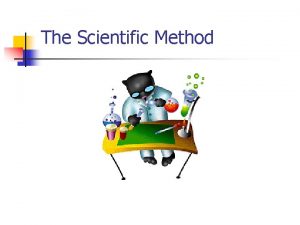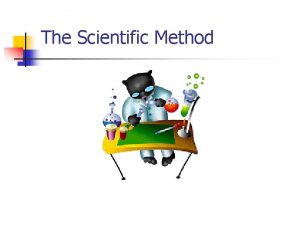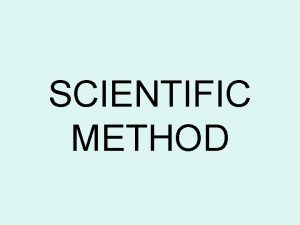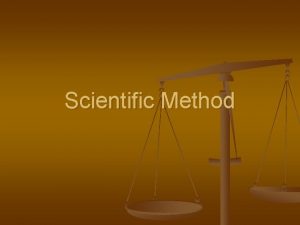Psychological Foundations Psychological Research The Scientific Method ensures































- Slides: 31

Psychological Foundations Psychological Research

The Scientific Method ensures that results are empirical, or grounded in objective, tangible evidence that can be observed time and time again, regardless of who is observing.

The Process of Scientific Research

Hypothesis or Theory? • Hypothesis: (plural: hypotheses) tentative and testable statement about the relationship between two or more variables • Theory: well-developed set of ideas that propose an explanation for observed phenomena

Theories and Hypotheses in the Scientific Method

Key Components of the Scientific Method • Fairness: implies that all data must be considered when evaluating a hypothesis • Falsifiable: It should be possible to disprove a theory or hypothesis by experimental results • Predictability: implies that a theory should enable us to make predictions about future events • Verifiability: an experiment must be replicable by another researcher

Ethics in Research with Human Participants Any research institution that receives federal support for research involving human participants must have access to an institutional review board (IRB), a committee of administrators, scientists, and community members that reviews proposals for research involving human participants to ensure that the participants are not harmed.

Informed Consent • An IRB will require informed consent from all participants. • A research participant must understand what to expect during an experiment, any risks involved, and the implications of the research, and then give written consent to participate. • In some cases researchers may use deception or purposely mislead experiment participants in order to maintain the integrity of the experiment. In these cases participants are debriefed, or told the truth after the experiment.

Ethics in Animal Research Institutional Animal Care and Use Committee (IACUC): a group of administrators, scientists, veterinarians, and community members that reviews proposals for research involving animals to ensure that research animals are treated humanely and inspects research facilities

Categories of Psychological Research • Descriptive research: research studies that do not test specific relationships between variables; they are used to describe general or specific behaviors and attributes that are observed and measured • Correlational research: tests whether a relationship exists between two or more variables • Experimental research: tests a hypothesis to determine cause and effect relationships

Common Types of Descriptive Research • Clinical or case study: observational research study focusing on one or a few people • Naturalistic observation: observation of behavior in its natural setting • Survey: list of questions to be answered by research participants allowing researchers to collect data from a large number of people. Surveys use a sample, or representative group, to learn more about a population

Other types of Descriptive Research • Archival research: method of research using past records or data sets to answer various research questions, or to search for interesting patterns or relationships • Cross-sectional research: compares multiple segments of a population at a single time • Longitudinal research: studies in which the same group of individuals is surveyed or measured repeatedly over an extended period of time

Issues with Descriptive Research • It may not be possible to generalize, or infer that the results for a sample apply to the larger population • Observer bias is when observations may be skewed to align with observer expectations • One way to assess observers is inter-rater reliability, a measure of agreement among observers on how they record and classify a particular event • It cannot test relationships between variables or cause and effect

Correlational Research Correlation means that there is a relationship between two or more variables. We can measure correlation by calculating the correlation coefficient, a number from -1 to +1 that indicates the strength and direction of the relationship between variables.

Limits of Correlational Research • Correlation does not prove cause and effect! • Some other factor, a confounding variable, could be causing the systematic movement in our variables of interest

Experimental Design: Participants • Basic design involves two groups: experimental group and the control group • Random samples ensure that the groups represent the larger population researchers are studying • Random assignment to control or experimental groups prevents differences between the two groups other than the independent variable being tested

Operational Definition A clear operational definition or description of how we will measure our variables is important so people can understand the results and the experiment can be replicated

Independent and Dependent Variables

Preventing Bias in Experiments Double blind studies where researchers and participants do not know which group received the treatment prevent experimenter bias and control for the placebo effect in participants The placebo effect is the influence of people’s expectations or beliefs on their experience in a given situation

Reliability and Validity Reliability: consistency and reproducibility of a given result Validity: accuracy of a given result in measuring what it is designed to measure

Distributional Thinking • Data vary. More specifically, values of a variable vary • Analyzing the pattern of variation, called the distribution of the variable, often reveals insights • It is important to look beyond averages and medians

Statistical Significance • A result is statistically significant if it is unlikely to arise by chance alone • This probability is referred to as a pvalue • The p-value tells you how often a random process would give a result at least as extreme as what was found in the actual study, assuming there was nothing other than random chance at play

Generalizability and Cause and Effect Random sampling is necessary to generalize results from our sample to a larger population, and random assignment is key to drawing cause-and-effect conclusions. With both kinds of randomness, probability models help us assess how much random variation we can expect in our results, in order to determine whether our results could happen by chance alone and to estimate a margin of error.

The Structure of a Psychology Research Article The American Psychological Association (APA) creates guidelines for how articles are structured which include: • Abstract • Introduction • Method • Results • Discussion

Abstract • The concise summary of the article • Summarizes the most important features of the manuscript, providing the reader with a global first impression on the article • Generally just one paragraph that explains the experiment as well as a short synopsis of the results

Introduction • Provides background information about the origin and purpose of performing the experiment or study • Reviews previous research and presents existing theories on the topic

Method • Covers the methodologies used to investigate the research question, including the identification of participants, procedures, and materials as well as a description of the actual procedure • Should be sufficiently detailed to allow for replication

Results • The results section presents key findings of the research, including reference to indicators of statistical significance

Discussion • Provides an interpretation of the findings, states their significance for current research, and derives implications for theory and practice • Alternative interpretations for findings are also provided, particularly when it is not possible to conclude for the directionality of the effects • Authors also acknowledge the strengths and limitations/weaknesses of the study and offer concrete directions about for future research

Practice Question • You read a news article that says that a person’s sex causes them to have better spatial memory • Using what you have learned about research design, how should you evaluate the claim? • What questions should you ask?

Quick Review • What is the scientific method? • How does the scientific method apply to psychology? • What are the strengths and weaknesses of descriptive, experimental, and correlational research? • What are the basic elements of a statistical investigation?
 Learning is explained in terms of wholeness of the problem
Learning is explained in terms of wholeness of the problem Scientific inquiry vs scientific method
Scientific inquiry vs scientific method Biogeochemical cycling ensures that
Biogeochemical cycling ensures that Entity integrity ensures correctness of the data in a table
Entity integrity ensures correctness of the data in a table Proving that a quadrilateral is a parallelogram quiz part 1
Proving that a quadrilateral is a parallelogram quiz part 1 Rating scale questions examples
Rating scale questions examples The protocol ensures freedom from deadlock.
The protocol ensures freedom from deadlock. Geometry unit 6 lesson 1 properties of parallelograms
Geometry unit 6 lesson 1 properties of parallelograms Foundations of clinical research applications to practice
Foundations of clinical research applications to practice How is a scientific law different from a scientific theory?
How is a scientific law different from a scientific theory? Research design vs research method
Research design vs research method Types of psychological research
Types of psychological research Conducting psychological research
Conducting psychological research Objectives of symposium
Objectives of symposium Hát kết hợp bộ gõ cơ thể
Hát kết hợp bộ gõ cơ thể Bổ thể
Bổ thể Tỉ lệ cơ thể trẻ em
Tỉ lệ cơ thể trẻ em Voi kéo gỗ như thế nào
Voi kéo gỗ như thế nào Chụp tư thế worms-breton
Chụp tư thế worms-breton Hát lên người ơi alleluia
Hát lên người ơi alleluia Các môn thể thao bắt đầu bằng tiếng nhảy
Các môn thể thao bắt đầu bằng tiếng nhảy Thế nào là hệ số cao nhất
Thế nào là hệ số cao nhất Các châu lục và đại dương trên thế giới
Các châu lục và đại dương trên thế giới Cong thức tính động năng
Cong thức tính động năng Trời xanh đây là của chúng ta thể thơ
Trời xanh đây là của chúng ta thể thơ Mật thư tọa độ 5x5
Mật thư tọa độ 5x5 101012 bằng
101012 bằng độ dài liên kết
độ dài liên kết Các châu lục và đại dương trên thế giới
Các châu lục và đại dương trên thế giới Thơ thất ngôn tứ tuyệt đường luật
Thơ thất ngôn tứ tuyệt đường luật Quá trình desamine hóa có thể tạo ra
Quá trình desamine hóa có thể tạo ra
